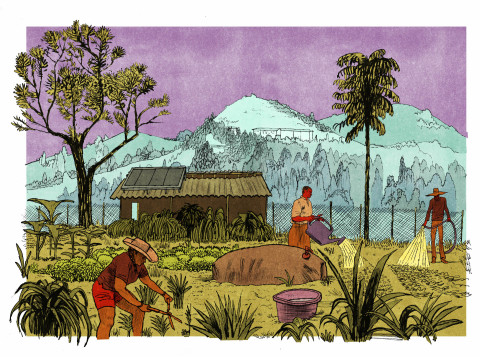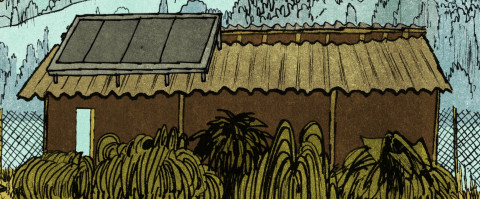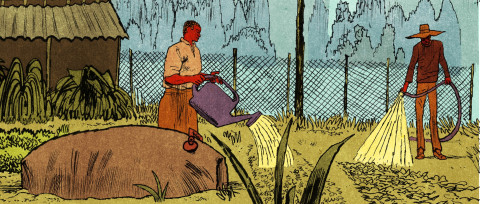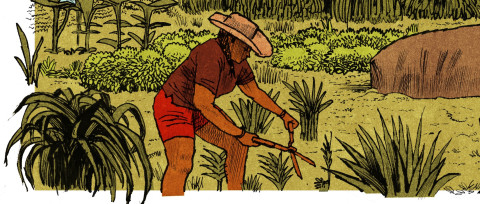Ideas into movement
Boost TNI's work
50 years. Hundreds of social struggles. Countless ideas turned into movement.
Support us as we celebrate our 50th anniversary in 2024.

Energy transformations require going beyond technological change to rethinking our entire energy model so that it strengthens community control, minimises waste, increases access to healthy food and clean water, and regenerates our environment. Across Latin America, countless communities are building these energy alternatives that pave the way for real transformation.

Illustration by Matt Rota©
As the world changes, harvesting water and energy… will be the most important thing to do. To maintain autonomy.1

Community-based approaches to alternative energies already have a long history. Since the late twentieth century, numerous communities have been confronted with extractivist and infrastructural projects, such as mega-dams, which threaten to destroy their lands and way of life. For example, the Sogamoso hydroelectric project in Colombia, built by the Canadian corporation Isagen on River Santander, destroyed the livelihoods of riverine communities. The dam’s wall prevented the migration of fish such as bocachico, which are the basis of the local economy. Furthermore, the river’s flow now depends on energy releases, and downstream communities often experience floods that destroy their crops and endanger their lives. Women have been among the most affected, as they lost fish sales and local tourism as sources of income. Young women also experienced abuse and violence, including sexual violence, during the construction of the dam.
What happened at the Sogamoso is not an isolated case. There are other riverine communities and territories that have still not been recognised as having been displaced by development and have often received no compensation. Criticism of the energy model, especially hydroelectric mega-dams, prompted Censat Agua Viva and other movements resisting dams in Colombia, both to stand up to the power of the large energy corporations, and also reflect on their relationship with energy and create solutions to achieve energy self-sufficiency and autonomy. A group of organisations gradually came together to push for an organisational2 and capacity-building process focused on energy issues.
The goal was to engage in the energy debate, create alternatives and tackle the climate and socio-environmental crisis. The resulting proposals aimed to establish new relationships with nature, energy and related technologies. The ideas this generated extend far beyond the current capitalist model and are connected to the ancestral practices and traditional knowledge that still exist across Colombia. This process was consolidated by the creation of the School for the Training of Technicians in Community Energies which has helped shape the concept of ‘community energies’.
This concept refers to knowledge, practices and transformation processes related to food and the production and consumption of energy. Community energies promote changes to the power relations in the mainstream energy system by redefining the relationship with nature and all forms of life, focusing on local self-sufficiency and autonomy and generating new forms and uses of energy that prevent waste and misuse, as well as decentralising energy generation, and also address the problems of water scarcity and pollution, deforestation, and loss of biodiversity and soil fertility. They help reduce greenhouse gas emissions (GHGs) and are essential to guaranteeing universal access to energy.
All these proposals are based on local realities, respond to specific needs, and show that socio-ecological transitions are viable and already underway. They are based on social processes that promote autonomy and a decent life and also defend our physical bodies and territories.3

Some examples of community energies are showcased in the Virtual Exhibition of Community Experiences for a Just Energy Transition, referred to earlier. The exhibition highlights and aims to give visibility to alternative energy initiatives and practices developed by social organisations across Latin America and the Caribbean. Box 1 sets out its objectives.
Box 1 Objectives of the Virtual Exhibition
|
By the end of 2023, the exhibition had recognised 119 experiences as energy autonomy alternatives, involving 21,083 families and 122,226 beneficiaries. The exhibition recognises a wide range of initiatives on the self-management of community energy that use technologies such as biodigesters, bicycle-powered machines, Pelton wheels and solar panels; and highlights experiences that link energy and water justice and food sovereignty (for instance peasant markets, agroecology, plant nurseries and family and community gardens). The exhibition also showcases experiences related to the reuse of organic and inorganic waste for energy and food production, as well as the production of arts and crafts. In addition, there are proposals on eco-neighbourhoods, self-management of health care by transforming medicinal plants into care products, the recovery and preservation of seeds and traditional dishes and rainwater harvesting among others.
While working with the community energies, both at the School for Technical Training and in the Virtual Exhibition, we have identified common challenges, one of which is the underestimation of their potential. It is often argued that it is impossible to sustain a country’s entire energy grid solely on the basis of community energies, a claim that raises several issues.
First, the energy transition is not only about changing the energy grid by using alternative technologies, but entails the more fundamental issue of our concept of energy. What purposes does it serve? And for whom should it be produced? By shifting the focus on the energy transition we may be better able to understand other crucial aspects, such as the need for a cultural change whereby energy is no longer treated as a commodity, but as a right and a common good that sustains the fabric of life, its care and what many peoples and communities defend as ‘buen vivir’ (living well), ‘Sumak Kawsay’ or ‘vivir sabroso’ (living joyfully). This is a discussion that needs to be situated in the local context of each territory and community.
Turning to Guatemala, the Community light in the Zona Reina in defence of the territory is a project in which several Mayan communities in the department of Quiché promote energy autonomy through the use of community turbines. These turbines emerged in communities displaced during the armed conflict from the late 1950s and particularly in the 1980s. The first initiative faced many difficulties, as they defied the corporate hydroelectric model that dispossesses communities of their lands and natural assets. However, the idea of community-run electricity spread to other communities and, with the support of the Madreselva Ecological Collective, more than 60 have adopted this initiative. The turbines generate considerable benefits for the local community and the fees managed by local authorities are affordable. They have also implemented community-based forest protection programmes and agroecological farming practices. Young trainees maintain the infrastructure, and the Collective continues to support projects and promote autonomy and a dignified life even in the face of extractivist models.
This brings us to a key issue: the question of scale. Extractivism and geopolitics have led to the belief that unless a given technology covers the entire system, it is useless. Therein lies a major trap that hinders people’s ability to deal with their own problems, taking account of local specificities and needs. Community energies challenge this view precisely because they are locally based but are not necessarily confined to that location in isolation, but take different forms in different regions and coordinate their efforts and capacities with other experiences – being community-based does not necessarily mean being isolated.
Another example is the use of biomass to generate energy. A major source of conflicts in rural and urban areas concerns the management of organic waste. In many cities, rubbish dumps or landfills are full, and some have even collapsed, with serious impacts for those living in the surrounding area. The proposal to use waste to produce energy and fertilisers is a response not only to this problem, but also to deforestation, which is the main cause of GHG emissions in most Latin American countries, including Colombia. The Colombian Network of Biomass Energy (RedBioCol), also a member of the Biolac Network, uses waste in biodigesters to reduce pressure on forests and jungles, generate energy, and reduce the costs of energy supply and fertilisers. It thus defies the energy and agri-food system that makes families dependent on expensive energy inputs and costs. The generation of gas from waste has strengthened local economies by adding value to their products and strengthening their energy autonomy. Often considered suitable only for rural areas, this technology has also been used in urban settings, such as universities, public institutions and even residential complexes.
Therefore, while fostering communities’ autonomy we should not conceive them as entities that are not open to dialogue with other experiences and even the public sector and the state, provided that the latter are receptive to the demands and needs of community energies, respect their autonomy and their own organisational structures. It is crucial that institutions recognise the nature of community energies and include them in developing public policies related to the food, energy and water systems. This should be done within a participatory land-use planning framework that acknowledges and incorporates the proposals that are already operational at the local level – which would require them to truly guarantee the right to participate in accordance with the needs and characteristics of local realities.
There should also be public funding for research on community energies, and a willingness to provide incentives, financing and support for such proposals as well as supporting the educational initiatives being developed at the local or regional level, and to promote broader public discussion on this issue. These educational initiatives should seek to strengthen experiences and local technical expertise to consolidate communities’ autonomy in implementing and maintaining the technologies. Moreover, communities should be supported to sell their surplus local energy to the main electricity grid and to their neighbours, without having to register as a public service company. It is also important to promote and support the development of community micro-grids.
In relation to scale, it is also important to highlight the experience of Adjuntas Pueblo Solar, led by Casa Pueblo. Faced with the devastation caused by Hurricane Maria in Puerto Rico, which left the population without electricity for several months, Casa Pueblo decided to launch what it called the ‘energy insurrection’ by implementing a process of converting the municipality of Adjuntas, a town with a population of 18,000 in a mountainous region of Puerto Rico, to solar power. Initially a movement to resist a mining project, this experience evolved into a process that gradually incorporated the debate on energy as a key to achieving energy autonomy and democracy. Adjuntas Pueblo Solar has installed hundreds of solar panels and started building their own micro-grids to generate their own energy autonomously, locally and in a decentralised way. Their approach prioritises the provision of basic services and the most vulnerable households, including those with medical needs who require constant technological assistance. Thanks to this initiative, they could now potentially become independent of the electricity grid in Puerto Rico, which is controlled by a corporate monopoly that is not only unresponsive in times of adversity but actually increases inequality. This experience exemplifies the potential of community energies to operate on a broad scale while putting autonomy and solidarity first.
Another common challenge that community energies face is related to the installation and maintenance of technologies and equipment due to the constraints imposed by technoscience and limited access to this knowledge. Technology plays a fundamental role in the energy industry, and powerful energy corporations have used it strategically to consolidate their dominance and create dependency on them. Their massive investments in infrastructure and technological development have enabled them to gain control over the generation, distribution and access to energy in most parts of the world. They have focused on conventional technologies, such as fossil fuel power plants and centralised distribution networks, which require large investments; once in place, they impede the entry of smaller, sustainable, community-based competitors. Moreover, they have promoted metering and data-management systems that supposedly improve energy efficiency but have also been used to maintain control and limit the choice of cleaner and decentralised energy sources of (pro)consumers. The result is the sustained reliance on highly polluting and expensive energy sources, thus perpetuating the influence of these major energy corporations, at the expense of more sustainable and decentralised alternatives.
Peoples and communities have always seen technology as an obstacle to being able to implement their projects. In response to this problem, the School for the Training of Technicians in Community Energies was set up to allow various grassroots community organisations to share experiences and conduct training aimed at improving the promotion and sustainability of technologies in communities that defend their territories and help improve production processes and the quality of life. At the school, communities have developed knowledge and exchanges on solar drying, efficient stoves, solar energy and biodigesters, as well as other ways of relating to energy, technologies and a local community. Juan Pablo Soler recalls the construction of the school:
In 2013, we began to create a methodological training process, which we have been redefining over time based on the things that learning by doing tells us we need to change – in other words, a methodology that is constantly being updated, that started as an exchange of experiences and now, has become a space, a training school. […] To build a school based on practice, and we began to incorporate some principles, ones based on, for example, “Learning by Doing”. In the case of alternative energies, we didn’t wait for someone from outside to come and install the technology in the territory because that would make us dependent on them. So, we started developing knowledge transfer educational systems to put an end to our dependence. The local residents are the ones who set up and operate the systems.4
Other challenges for community energies include access to and the cost of certain materials, centralised power generation, limited knowledge dissemination, the lack of political will, government support and policies that foster and strengthen energy autonomy and decentralisation, the privatisation of services and common goods such as water and energy, the impacts of the climate crisis, political violence and the criminalisation of the work of social organisations, the lack of focus on radical change in some approaches to the energy transition and the post-growth debates.
Thus, many of the challenges facing community energies are rooted in the differences in the way we conceive energy, how it is produced, for whom and for what purpose. Despite this, community energies have succeeded in overcoming some of these obstacles, usually through forms of mingas or mano compartida (community work), convites (community meetings) and other traditional local practices that help them break down economic barriers. Community revolving funds have also been used to make loans individual projects, as in the case of the indigenous communities of Tolima, with the support of Grupo Semillas (Seeds Group). Occasionally they have also received small amounts of external funding to help develop a local-level project. Finally, local governments have also supported community projects, as in the case of Lebrija in Santander, where moved by the experience of the School for Technical Training, the mayor decided to fund the construction of hundreds of stoves, with the help of community technicians.
These experiences demonstrate that community management of energy is viable and that communities can achieve energy autonomy, create concrete proposals for moving away from fossil fuel-based energy, while developing technological and methodological innovations in the process, and diversify their energy sources. They also illustrate that women can actively participate in building and sustaining this kind of experience. They provide examples of the creation and intergenerational transmission of knowledge, improvements to the quality of life and show that communities can re-assert their own ways of conceiving of and living in the world. In short, these proposals bring together knowledge and practices that create and propose more just and sustainable worlds based on autonomy and dignity. They involve a broader understanding of energy and our relationship to it and cultural exchanges that lead to a more conscious use of energy and our common goods, thus contributing to a more comprehensive understanding and lived experiences of socioecological transitions.
In terms of their comprehensiveness, several proposals related to community energies have adopted multidimensional approaches that combine different energy sources, organisational or community processes, and their own contextual knowledge. Here, we would highlight the experience of The Baskets of technologies and practices: a proposal for energy and food sovereignty of Lo Bueno del Monte, led by the UTA Foundation and the Tosoly Farm ‘Lo Bueno del Monte’ in Santander in Colombia. This initiative works to revive traditional farming practices for producing rice and wheat to reinforce food sovereignty based on an agroecological approach. To achieve this, they created the ‘Sustainable Lifestyle Schools’, where they explored and proposed the concept of ‘community baskets of technologies and practices’. To create these baskets, communities have to present detailed proposals based on their specific reality and plans, which include information on the equipment and knowledge required for agricultural production (e.g. production of biofertilisers, rainwater harvesting, family gardens), self-management of energy (e.g. biodigesters, solar dryers, and bicycle-powered machines, among others), and the exchange of knowledge and collective work in rural communities.
Comprehensive community energy proposals recognise and integrate multiple energy flows ranging from the sun, food and human energy to various production processes. These proposals are designed to respond to various community needs. They regard relationships as ongoing, mutual exchanges among different elements of nature, rather than simply market transactions. In the case of the UTA and the Finca Tosoly ‘Lo Bueno del Monte’ initiative, they have managed to help several rural families coordinate to develop energy and food sovereignty, thereby strengthening their production activities. There are also many experiences that integrate a variety of practices, knowledge and technical tools designed to address the needs and priorities of their own specific contexts.

Women play a crucial role in developing and sustaining these initiatives and contribute to projects whose main objective is to build a dignified life, ensure their permanence in the territories and promote ‘good living’ for their families and communities. Often, without thinking of themselves as feminists, the women engage in anti-patriarchal, anti-capitalist and anti-extractivist practices and promote an alternative cosmovision. They focus on eco-dependence and interdependence, the fight against the commodification of water, land and energy and the defence of territorial autonomy. The prevailing discourse on energy and the transition tends to be male-dominated and linked to corporate interests, and therefore excludes other relevant voices and perspectives. However, we believe that concentrating on proposals that explore other ways of relating to energy creates a space for diverse voices from the community, the territory, women, youth, and children, among others.
Some of these projects have helped facilitate women’s daily chores related to care work and the social reproduction of life. The experience of the Mujeres de Roble Greenhouse: Solar energy for planting medicinal plants and just transitions led by a group of Afro-descendant women in the Valle del Cauca is a noteworthy example. These women installed cisterns and a rainwater-harvesting system, meaning that they no longer need to travel long distances to fetch water like they used to. Furthermore, the greenhouse is now equipped with solar panels that enable them to harvest solar energy for various activities. They can listen to the radio and continue working in the greenhouse after sunset, allowing them to spend more time with their co-workers. The greenhouse has also become a source of income, as it is where they grow and transform medicinal plants into health products, which both contributes to their economic autonomy, and also strengthens their community role in recuperating ancestral knowledge.
Another example along these lines are efficient stoves, ‘which consume less wood, thus helping to reduce deforestation. In addition, ‘wood gardens’ are promoted to produce the necessary fuel so that women and children no longer have to go out to gather large amounts of firewood. The stoves also improve women’s health and reduce the respiratory problems caused by traditional wood stoves. The Efficient wood-burning stoves and wood gardens for community-based forest conservation and good living is a concrete example of this.

Illustration by Matt Rota©
To meet the urgent need to transform the energy system in the context of socio-ecological transitions calls for a profound sociocultural transformation of the existing approach to production, management, ownership and consumption. This involves reconfiguring the hegemonic energy model, marked by the concentration of large private corporations that control the generation and distribution of energy. We must move towards an alternative approach that grants local initiatives a central role, democratises energy production and generation and promotes these proposals based on a cross-sectoral approach, which is driven by organisations, communities, cooperatives and other forms of community organisation.
More specifically, institutions should offer tax incentives and financing to strengthen, develop and implement this kind of experience, alongside a favourable regulatory framework that recognises and promotes such initiatives. In addition, access to the public power grid should facilitate the integration of power generated at the community level, establish mechanisms for fair payment of surplus energy contributed to the grid and permit its commercialisation among neighbours. Furthermore, it is essential to ensure the participation and involvement of these experiences in decision-making processes for the energy system, as well as the defence and vision of the territory – one that regards food, energy and water not as separate, and develops more integrated views, pathways and policies. Other aspects that need further exploration include the promotion and national development of technologies and materials that reduce dependency and the costs of inputs.
These questions lead us to the need to raise the visibility and strengthen community energies so that they can increasingly form a network and an alternative system that promotes care and the reproduction of life through the energy, food and water sovereignty of each region. Community energies need guarantees for their proposals. They also require more visibility and to be recognised and respected, highlighting their community and autonomous nature as a core factor. There is also a need to establish an equitable relationship between them and the national and international energy system, which transforms the power relations imposed by big energy corporations, which implies recognising them as essential actors rather than seeking to co-opt or force them to adopt formal structures as companies or other entities. These need to be supported, among other measures, by financial incentives, training and capacity-building programmes for local developers, support to reduce national industries’ dependence on foreign technology, and local technical assistance programmes.
The just energy transition will progress the more we take control of energy, how it is produced and how we choose to use it.
Strengthening community energies means putting the reproduction of life in the centre!